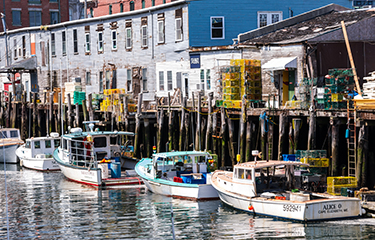Maine is among the latest states have had CARES Act spend-plans approved by NOAA, bringing the current total of states with approved plans to 12 as of 29 September.
Maine – along with Alabama, North Carolina, Rhode Island, and Virginia – have all had spend plans approved and can now begin the application process for fishery participants. The states join California, Georgia, Louisiana, Massachusetts, Oregon, and South Carolina.
In addition, Louisiana’s spend plan has opened its application process, with a closing date of 26 October, revealing how the state plans to allocate its funds.
Maine represents, by far, the largest recipient of CARES Act funding, in the latest batch of approvals. The state is receiving a total of USD 20.3 million (EUR 17.3 million) of the USD 300 million (EUR 257 million) that was allocated back in May. Of approved states, that funding level puts it just behind Massachusetts, which has had its USD 28 million (EUR 23 million) batch of funding approved since August.
Maine decided how to allocate the funds with the help of industry stakeholders, sending out a survey to all license-holders for which the Maine Department of Marine Resources (DMR) had a valid email address – approximately 9,485 people. Of those 883 – or just under 10 percent – responded.
The survey indicated that the vast majority of respondents preferred to receive a one-time direct payment, which is the solution that Maine DMR chose.
The state also acknowledged that the industry has been hit hard by COVID-19.
“Maine’s fishing related businesses have suffered significantly since the beginning of the coronavirus pandemic,” the spend plan states.
The Maine spend plan is using the percentages NOAA used when the administration made its initial determination on how to allocate the USD 300 million in funds. That determination used data on the revenue generated by each sector in the state, which Maine DMR itself used to split the funds out. In total, 81.8 percent of the funds, or just over USD 15.6 million (EUR 13.2 million), will go to commercial fishing, aquaculture, and for hire; while 18.1 percent, or just over USD 3.4 million (2.8 million), will go to dealers and processors. A remaining USD 1 million (EUR 852,000) will go to a marketing campaign intended to boost seafood purchasing.
Those eligible for payment must be a Maine resident, older than 18 years or older at the closure of the application process, and must have held a lease or license – or been otherwise authorized to participate in the sector – in 2019.
“Some Maine businesses derive their income from multiple sectors. Because the commercial fishing, aquaculture and for hire charter businesses have been grouped, individuals within these sectors will only be eligible for one payment, regardless if they participate in more than one activity,” the spend plan states. “However, those individuals will also be eligible to apply within the dealer/processor sector if they are also licensed in shoreside businesses and can demonstrate a revenue loss from those activities of greater than 35 percent.”
All payments made to qualified individuals in the commercial fishing, aquaculture, or for hire sectors will be the same, as the Maine DMR assessed that it could not determine the size of need among the different “on-the-water” sectors, so “absent any other basis for distinguishing between individuals, the fairest thing to do would be to give each participant the same payment.”
The same application standards are true for the dealer/processor sector. Each entity that qualifies will receive the same payment from the total funding available.
While most of the process is the same, key part of qualifying for aid – proving that revenue loss met or exceeded 35 percent – will differ between the two sectors.
"To prevent individual harvesters from having to go through the difficult and time-consuming process of verifying their eligibility to apply for the relief funds based on the criteria that their 2020 revenue loss exceeded 35 percent of the previous five-year average, I had our landings program complete this work," Maine DMR Comissioner Patrick Keliher wrote in an email to industry members. "For other segments of the industry, such as recreational fishing guides, wholesale dealers, and aquaculture operations, it will be up to the individual or business as we don’t have the necessary information to make the loss determination."
As part of the spend plan, the Maine DMR also established a new “Maine Seafood Marketing Plan.” The Maine DMR has reached out to Weber Shandwick, the agency of record for the Maine Lobster Marketing Collaborative, to “begin discussions about marketing strategies and tactics to brand and promote Maine seafood.” The goal is to drive consumer demand for Maine seafood, and improve domestic markets.
The plan also acknowledges that in the face of the scale of the economic impacts of COVID-19, the current aid will not even come close to offsetting the hardships many fishermen are dealing with.
“Just the landed value of Maine’s commercial fishing and aquaculture industries is nearly USD 600 million [EUR 511 million] annually. There is an additional USD 1.5 billion [EUR 1.2 billion] in economic activity associated with shoreside lobster businesses alone.” the spend plan states. “A 35 percent reduction of revenues for these industries, which likely have a combined value of close to USD 3 billion [EUR 2.5 billion], is over USD 1 billion [EUR 852 million]. While Maine DMR has sought to fairly and efficiently distribute the available USD 20 million [EUR 17 million] across the eligible sectors and individuals, it is clear that USD 20 million cannot come close to addressing the impacts that are currently being endured.”
Photo courtesy of James Mattil/Shutterstock







